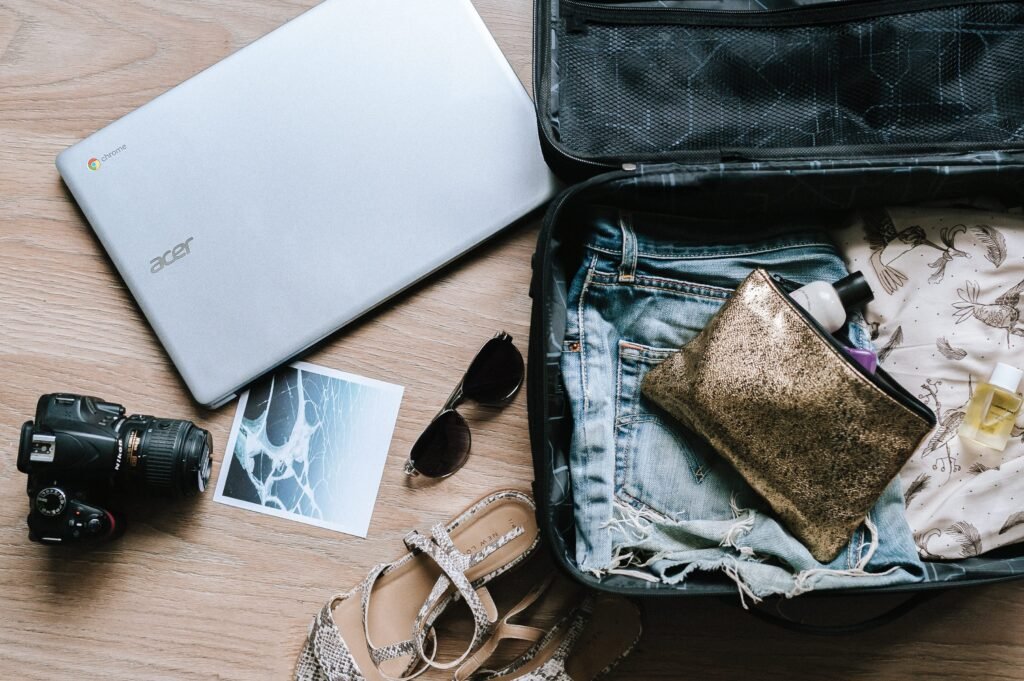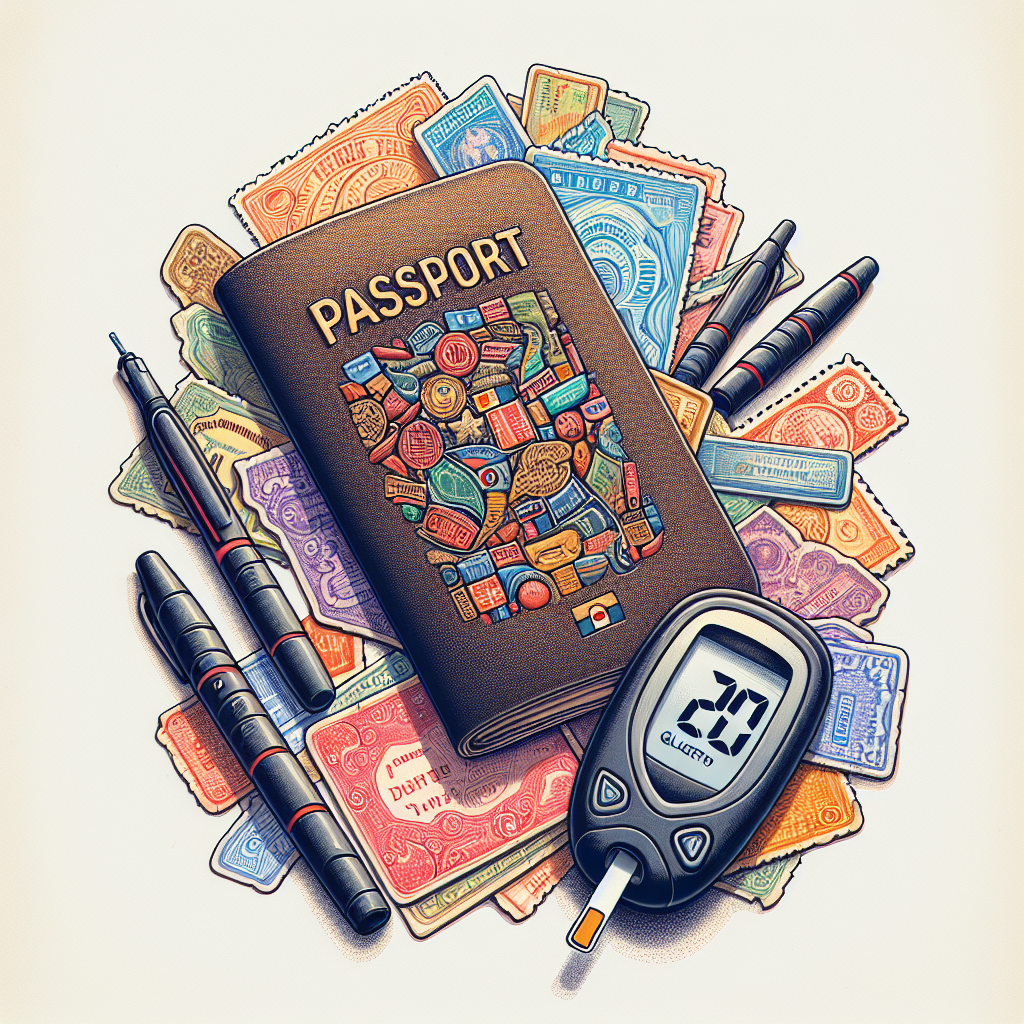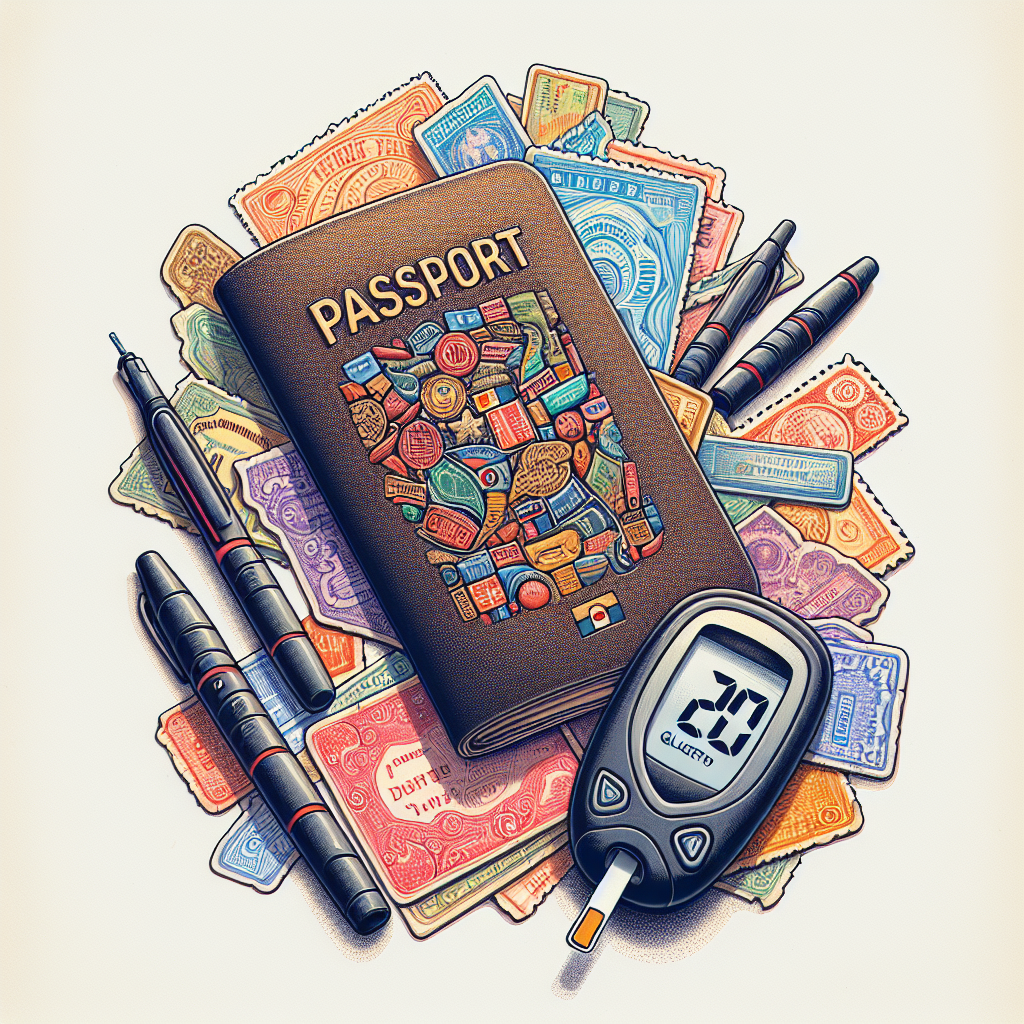If you or someone you know is living with diabetes, you may have wondered about the challenges of traveling internationally with this condition. From managing medication and blood sugar levels to navigating unfamiliar food options, there are several factors to consider. In this article, we will explore some practical tips and strategies that can help make traveling abroad as a diabetic a smoother and more enjoyable experience. Whether you are planning a sightseeing vacation or a business trip, we understand the importance of taking care of your health while exploring new horizons.
Choosing the Right Destination
Considerations for Destination Choice
When traveling internationally as a diabetic, it is crucial to carefully consider the destination. Certain factors can greatly impact the management of your diabetes, such as the availability of medical facilities, access to diabetic supplies and medications, and the overall suitability of the environment for your health needs. Consider destinations that have a well-developed healthcare system, reliable access to diabetic supplies, and a generally safe and supportive environment for individuals with diabetes.
Researching Medical Facilities in the Destination
Before embarking on your international adventure, it is important to conduct thorough research on the medical facilities available at your chosen destination. Look for hospitals and clinics that have experience in managing diabetes and offer specialized services for diabetic patients. Make a list of these facilities along with their contact information and keep it easily accessible during your trip. This way, you can seek medical assistance if needed and have peace of mind knowing that you are prepared.
Availability of Diabetic Supplies and Medications
Another crucial aspect to consider when choosing a destination is the availability of diabetic supplies and medications. Contact local pharmacies or research online to ensure that you will be able to obtain the necessary supplies and medications for your diabetes management. It is also wise to pack extra supplies in case of any unforeseen circumstances. By ensuring the availability of these essential items, you can alleviate any potential stress or difficulties during your travels.
Planning Ahead
Consulting with a Healthcare Provider
Before embarking on your international journey, it is advisable to consult with your healthcare provider or diabetes specialist. They can provide invaluable guidance and advice on managing your diabetes while traveling. Your healthcare provider can also help determine if any adjustments need to be made to your medication or insulin doses based on the duration of your trip and potential changes in time zones. This consultation will help you feel more confident and prepared for your travels.
Obtaining Necessary Travel Documents
When traveling internationally, it is essential to have all the necessary travel documents in order. This includes a valid passport, visas (if required), and any additional documentation related to your diabetes. Some countries may have specific requirements for individuals with diabetes, such as a medical certificate or a letter from your healthcare provider explaining your condition and the need for diabetic supplies and medications. Research the entry requirements for your destination well in advance to avoid any last-minute complications.
Ensuring Adequate Travel Insurance Coverage
Travel insurance is an essential aspect of planning any trip, especially for individuals with pre-existing medical conditions like diabetes. Before traveling internationally, make sure to review your current insurance coverage and determine if it is adequate for your needs. Consider obtaining travel insurance that specifically covers diabetes-related medical expenses, including emergency medical evacuation in case of a severe health crisis. This will give you peace of mind and protect you from unexpected financial burdens while abroad.
Packing Sufficient Diabetes Supplies and Medications
When it comes to packing for your international trip as a diabetic, it is crucial to ensure that you have more than enough supplies and medications to last the duration of your journey. Take into account any potential delays or unforeseen circumstances that may extend your trip. Pack extra test strips, lancets, insulin, syringes or insulin pens, and any other necessary diabetic supplies. It is also wise to keep your medications and supplies in your carry-on bag to avoid any loss or damage in case your checked luggage is misplaced.

Managing Blood Sugar Levels during Travel
Adjusting Basal Insulin Doses for Different Time Zones
Traveling across different time zones can significantly impact your diabetes management. To mitigate the effects of jet lag on your blood sugar levels, it is important to adjust your basal insulin doses accordingly. Consult with your healthcare provider to determine the appropriate adjustments to make based on the time zones you will be crossing. Following their recommendations will help maintain stable blood sugar levels throughout your journey and reduce the risk of hypoglycemia or hyperglycemia.
Handling Meal Planning and Dining Out
Managing your meals and dining options can be challenging when traveling internationally as a diabetic. Research the local cuisine and familiarize yourself with the carbohydrate content of different foods commonly available at your destination. This knowledge will help you make informed choices while dining out and make appropriate adjustments to your insulin dosing. It is also beneficial to carry healthy snacks with you to ensure you have suitable options between meals.
Staying Hydrated and Maintaining a Healthy Diet
It is essential to prioritize staying hydrated and maintaining a healthy diet while traveling. Dehydration can impact your blood sugar levels and overall well-being, so make sure to drink plenty of water throughout your journey. Additionally, strive to consume a balanced diet with a focus on whole foods, fruits, vegetables, and lean proteins. This will provide you with the necessary nutrients and help keep your blood sugar levels stable.
Monitoring Blood Glucose Levels Regularly
Regular blood glucose monitoring is crucial during travel to ensure proper diabetes management. Carry a reliable blood glucose meter with you and test your blood sugar levels frequently, especially after meals and physical activities. This will allow you to make timely adjustments to your insulin doses or diet as needed. Stay vigilant and proactive in monitoring your blood glucose levels to maintain control of your diabetes while enjoying your international adventure.
Navigating Airport Security and Customs
Informing Airport Security Personnel about Diabetes
When going through airport security, it is important to inform the security personnel about your diabetes and any medical supplies or insulin you are carrying. This will help prevent any misunderstandings or potential issues during the security screening process. You may be required to provide specific information or have your supplies inspected separately. Being proactive and communicative will ensure a smoother experience at the airport.
Carrying a Medical Certificate
To facilitate the airport security process, consider carrying a medical certificate or letter from your healthcare provider confirming your diabetes diagnosis and the need for insulin and other supplies. This certificate can provide clarity to security personnel if any questions or concerns arise. Make sure the certificate includes your contact information, the generic and brand names of your medications, and any specific instructions for handling your supplies.
Organizing Diabetes Supplies for Security Screening
To streamline the security screening process, organize your diabetes supplies in a separate pouch or bag within your carry-on luggage. This will make it easier to present them for inspection if requested by security personnel. Keep your supplies well-organized and easily accessible to avoid delays or additional stress during airport security checks.
Navigating Customs Regulations for Medications
When traveling with medications, including insulin, it is important to research and understand the customs regulations of your destination country. Some countries may have specific restrictions or requirements for importing certain medications or quantities. Ensure that you have the necessary documentation, such as a copy of your prescription or a letter from your healthcare provider, to satisfy customs requirements. It is recommended to carry your medications in their original packaging to clearly identify them.

Adapting to the Local Environment
Understanding the Local Food Culture and Carbohydrate Content
Every destination has its unique food culture, and as a diabetic traveler, it is important to familiarize yourself with the local cuisine and its carbohydrate content. Research local dishes, ingredients, and portion sizes to make informed choices when dining out or buying groceries. Consider using mobile apps or online resources that provide nutritional information for local foods. This knowledge will help you plan your meals and manage your blood sugar levels effectively.
Communicating Dietary Needs and Restrictions
When traveling internationally, it is essential to communicate your dietary needs and restrictions to local establishments, such as restaurants or hotels. Inform them about your diabetes and any specific dietary requirements, such as avoiding high-sugar or high-carbohydrate foods. Be polite but assertive in explaining your needs so that they can accommodate you appropriately. Language barriers may pose a challenge, so learning a few key phrases or carrying a translation card can be helpful.
Staying Active and Incorporating Exercise
Maintaining an active lifestyle while traveling can positively impact your diabetes management. Look for opportunities to incorporate exercise into your daily routine, such as walking tours, hiking, or exploring the local surroundings on foot. Regular physical activity can help regulate blood sugar levels and improve insulin sensitivity. Additionally, consider packing resistance bands or small exercise equipment that can be easily used in hotel rooms or outdoor spaces.
Accounting for Climate Changes and Temperature Extremes
Different climates and temperature extremes can have an impact on your diabetes management. In hot or humid environments, be aware of the potential for insulin degradation due to excessive heat. Store your insulin properly and consider using a cooling pack or a small insulated bag to protect it from extreme temperatures. Similarly, in cold environments, ensure that your insulin is not exposed to freezing temperatures, as it may lose its effectiveness. Monitor your blood sugar levels closely and make necessary adjustments to your diabetes management plan to accommodate these environmental factors.
Emergency Preparedness
Identifying Emergency Medical Facilities in the Destination
While we hope for the best, it is essential to be prepared for any emergencies that may arise during your international travel. Research and identify emergency medical facilities, such as hospitals or clinics, at your destination beforehand. Keep their contact information easily accessible and share it with your travel companions. Knowing where to seek medical assistance in case of an emergency will give you peace of mind and enable you to act swiftly if the need arises.
Carrying Emergency Contact Information
Always carry your emergency contact information with you while traveling abroad. This includes the contact details of your healthcare provider, a trusted family member or friend, and your insurance provider. Having these contacts readily available can facilitate any necessary communication or coordination in case of an emergency.
Communicating Diabetes-related Symptoms to Others
It is important to be able to communicate your diabetes-related symptoms to others while traveling internationally. Learn key phrases or have a translation card available that explains your condition, symptoms of low or high blood sugar, and the need for prompt medical attention if necessary. This will enable you to seek assistance or communicate your needs effectively, even in situations where language barriers may exist.
Preparing for Unexpected Situations
Unexpected situations can occur while traveling, and as a diabetic, it is essential to be prepared. Pack an emergency kit with extra supplies, such as syringes, test strips, and glucose gel or tablets, to help you manage unforeseen circumstances. In addition, consider carrying a medical alert bracelet or necklace that clearly identifies your condition to ensure prompt and effective medical attention if needed.

Dealing with Language Barriers
Learning Basic Diabetes-related Vocabulary
When traveling abroad, especially to countries where English may not be widely spoken, learning basic diabetes-related vocabulary can be extremely helpful. Familiarize yourself with important terms such as “diabetes,” “insulin,” “blood sugar,” and “emergency” in the local language. This will enable you to communicate your needs more effectively and seek assistance when required.
Carrying a Diabetes Identification Card in Multiple Languages
A diabetes identification card in multiple languages can provide essential information about your condition to medical professionals or others who may need to assist you. Include details such as your name, contact information, type of diabetes, medications you are taking, allergies, and any other relevant medical conditions. Carrying this card can save valuable time and ensure proper care in case of an emergency.
Utilizing Translation Apps or Services
In situations where language barriers are a challenge, utilizing translation apps or services can be immensely beneficial. There are several mobile apps available that can help you translate conversations or important information instantly. Alternatively, consider using professional translation services for more complex interactions. Having access to translation tools will greatly facilitate communication and help ensure your diabetes-related needs are properly understood.
Seeking Assistance from Local Diabetes Organizations
In many countries, local diabetes organizations or support groups exist to provide assistance and resources to individuals with diabetes. Reach out to these organizations before your trip or upon arrival at your destination. They can provide valuable information, connect you with local healthcare providers or diabetes educators, and offer guidance specific to your destination. Seeking assistance from such organizations can help you navigate the challenges of managing diabetes in a foreign environment.
Seeking Support and Connecting with Others
Joining Diabetic Travel Support Groups or Forums
Finding a community of fellow diabetics who share your passion for travel can be incredibly empowering and enlightening. Joining diabetic travel support groups or online forums will allow you to connect with individuals who have experienced similar challenges and can offer valuable insights and tips. These platforms also serve as a great source of support, inspiration, and encouragement, making your journey as a diabetic traveler even more enjoyable.
Contacting Diabetes Associations in the Destination
Another way to seek support and connect with others while traveling internationally is by contacting local diabetes associations or organizations in your destination country. These associations often have resources and networks that can assist you with any specific concerns or questions. Reach out to them for guidance, local recommendations, or even to connect with fellow individuals living with diabetes in the area. Connecting with these associations can add an extra layer of support and help you feel more at ease during your travels.
Finding Local Diabetes Educators or Healthcare Providers
While traveling, it can be beneficial to have access to local diabetes educators or healthcare providers who can offer specific guidance and support. Research and identify healthcare professionals with expertise in diabetes management at your destination. Reach out to them before or during your trip to establish a connection and schedule an appointment if needed. Having a local expert to turn to can greatly enhance your diabetes care while abroad.
Connecting with Fellow Traveling Diabetics
In addition to engaging with the online diabetic travel community, consider connecting with fellow traveling diabetics who are visiting the same destination as you. There are various online platforms that facilitate communication and meetups among travelers with diabetes. Meeting up with individuals who are going through similar experiences can be comforting and provide opportunities to share tips, experiences, and support.

Maintaining a Routine and Self-care
Establishing a Daily Diabetes Care Routine
Traveling may disrupt your typical daily routine, but it is essential to establish a new diabetes care routine during your journey. Set reminders for your medication or insulin doses, blood sugar monitoring, and meal times to ensure you maintain consistency in managing your diabetes. Adjust your routine to fit the activities and schedule of your destination, but prioritize your diabetes care to maintain stability and keep your blood sugar levels in check.
Taking Time for Rest and Self-care
Traveling can be exciting and packed with numerous activities, but it is important not to neglect rest and self-care. Adequate rest and relaxation are essential for managing stress levels and maintaining overall well-being. Listen to your body and take breaks when needed. Find moments to do activities that bring you joy and help you recharge. Engaging in activities like meditation, yoga, or deep breathing exercises can also contribute to your mental and emotional well-being.
Managing Stress and Mental Well-being
Traveling, particularly internationally, can sometimes be accompanied by stressors and challenges. Stress can impact your blood sugar levels, so it is vital to manage it effectively. Find healthy ways to cope with stress, such as practicing mindfulness, engaging in physical activity, or seeking support from loved ones or travel companions. Prioritizing your mental well-being will contribute to better diabetes management and enhance your overall travel experience.
Keeping a Travel Diary or Logbook
Maintaining a travel diary or logbook can be a helpful tool for managing your diabetes and reflecting on your experiences. Use it to track your blood sugar levels, medication doses, meals, and activities throughout your trip. This information can be shared with your healthcare provider during your post-travel appointment to gain insights into how different factors may have influenced your diabetes management. Additionally, a travel diary can serve as a memento of your journey and help you relive the memorable moments.
Returning Home and Follow-up Care
Scheduling a Follow-up Appointment with Healthcare Provider
Upon returning home from your international travel, it is advisable to schedule a follow-up appointment with your healthcare provider or diabetes specialist. During this appointment, discuss any observations or concerns you had during your trip and seek their feedback on your diabetes management. Review your blood sugar levels and any adjustments made to your medication or insulin doses during your travel. This follow-up care is crucial to ensure a smooth transition back to your regular diabetes management routine.
Monitoring Blood Sugar Levels Post-travel
It is important to continue monitoring your blood sugar levels closely in the days and weeks following your international travel. Changes in routine, diet, and activity levels during your trip may have residual effects on your blood sugar levels. Keep a close eye on any patterns or trends that may emerge and make necessary adjustments to your diabetes management plan in consultation with your healthcare provider.
Reflecting on the Experience and Lessons Learned
Upon returning home, take the time to reflect on your international travel experience as a diabetic. Consider what went well and what challenges you encountered. Reflect on how you managed your diabetes and any adjustments you made during your journey. It is also beneficial to think about what you learned or discovered about yourself and your diabetes management strategies. This reflection will help you grow, learn, and be better prepared for future travel experiences.
Sharing Travel Experience with Diabetes Community
Sharing your travel experience with the broader diabetes community can be beneficial for both you and others. Consider writing about your journey in a blog post, article, or social media platform dedicated to diabetes travel. By sharing your story, insights, and tips, you can help inspire and educate fellow individuals with diabetes who aspire to travel internationally. Your experience may provide valuable guidance, encouragement, and a sense of community to others embarking on similar adventures.
As a diabetic, international travel may require some additional planning and considerations, but it should not deter you from exploring the world. With thorough preparation, proactive management, and a supportive mindset, you can confidently embark on your international adventure while effectively managing your diabetes. Remember to seek guidance from your healthcare provider and connect with the diabetes community to make your journey as enjoyable and successful as possible.


